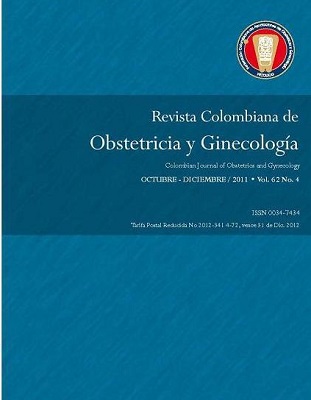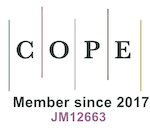Sellantes de fibrina en ginecología laparoscópica. Aspectos moleculares y mecanismo de acción: revisión de la literatura
DOI:
https://doi.org/10.18597/rcog.172Palabras clave:
sellante de fibrina, hemostático, adhesivo, ginecología, laparoscopiaResumen
Objetivo: hacer una revisión sobre la actividad biológica y mecanismo de acción de los sellantes de fibrina en ginecología laparoscópica.
Materiales y métodos: se realizó una búsqueda de la literatura publicada tanto en inglés como en español a través de Medline vía PubMed, Ovid y Cochrane, desde 1993 a 2010. Se analizaron los artículos que incluían el uso de los sellantes en ginecología laparoscópica y se agruparon por temáticas tales como antecedentes, actividad biológica, composición, administración y características biofísicas.
Resultados: se encontraron entre 1993 y 2010, 200 artículos de los cuales 49 correspondían a los criterios establecidos siendo objeto de análisis. Los sellantes de fibrina contribuyen al logro de la hemostasia aumentando la expresión en las células peritoneales de los activadores e inhibidores del plasminógeno, afectando el proceso de curación, que puede ser de beneficio en la reducción de las adherencias posoperatorias.
Conclusión: el desarrollo de los sellantes de fibrina surge como una alternativa práctica para la reducción de la hemorragia y control de la hemostasia, además de la reducción de las adherencias posoperatorias en la cirugía laparoscópica ginecológica.
Biografía del autor/a
Hernando Navarro-Newball
William García-Gutiérrez
Residente de IV año Ginecología y Obstetricia Universidad Libre. Cali, (Colombia)
Eliana Paredes-Becerra
Referencias bibliográficas
Busuttil RW. A comparison of antifibrinolytic agents used in hemostatic fibrin sealants. J Am Coll Surg 2003;197:1021-8.
Reece TB, Maxey TS, Kron IL. A prospectus on tissue adhesives. Am J Surg 2001;187:40S-44S.
Jackson MR, MacPhee MJ, Drohan WN, Alving BM. Fibrin sealant: current and potential clinical applications. Blood Coagul Fibrinol 1996;7:737-46.
Hackethal A, Brüggmann. Surgical treatment of fibroids in Hessel, Germany, between 1998 and 2004. Fertil Steril 2008;91:862-8.
Carr ME Jr, Martin EJ, Ambrose H. Fibrin sealants. En: Wnek GE, Bowlin GL, editors. Encyclopedia of Biomaterials and Biomedical Engineering. New york: Marcel Dekker; 2004. p. 611-20.
Diamond M, Kruger M, Saed GM. Effect of Tisseel on expression of tissue plasminogen activator and plasminogen activator inhibitor-1. Fertil Steril 2004;80:1657-64.
Dodd RA, Cornwell R, Holm NE, Garbarsch A, Hollingsbee DA. The Vivostat application system: a comparison with conventional fibrin sealant application systems. Technol Health Care 2002;10:401-11.
Bar L, Malka O, Naboichenko E, Nur I. The binding of fibrin sealant to collagen is influenced by the method of purification and the cross-linked fibrinogen-fibronectin (heteronectin) content of the 'fibrinogen' component. Blood Coagul Fibrinolysis 2005;16:111-7.
Rivoire HC, Fagundes DJ. Surgical adhesives and tubal sterilization: an experimental study. J Obstet Gynaecol Res 2008;34:218-27.
Petter-Puchner AH, Walder N, Redl H, Schwab R, Ohlinger W, Gruber-Blum S, et al. Fibrin sealant (Tissucol) enhances tissue integration of condensed polytetrafluoroethylene meshes and reduces early adhesion formation in experimental intraabdominal peritoneal onlay mesh repair. J Surg Res 2008;150:190-5.
Lovisetto F, Zonta S, Rota E, Mazzilli M, Bardone M, Bottero L, et al. Use of human fibrin glue (Tissucol) versus staples for mesh fixation in laparoscopic transabdominal preperitoneal hernioplasty: a prospective, randomized study. Ann Surg 2007;245:222-31.
Buchta C, Hedrich HC, Macher M, Höcker P, Redl H. Biochemical characterization of autologous fibrin sealants produced by CryoSeal and Vivostat in comparison to the homologous fibrin sealant product Tissucol/Tisseel. Biomaterials 2005;26:6233-41.
MacGillivray TE. Fibrin sealants and glues. J Card Surg 2003;18:480-5.
Lima AG, Taha M, Rivoire HC, Fagundes AT, Fagundes DJ. Fibrin adhesive and the vaginal vault synthesis on female rabbits abdominal hysterectomies. Acta Cir Bras 2009;24:30-5.
Sierra DH. Fibrin sealant adhesive systems: a review of their chemistry, material properties and clinical applications. J Biomater Appl 1993;7:309-52.
Elvin CM, Brownlee AG, Huson MG, Tebb TA, Kim M, Lyons RE, et al. The development of photochemically crosslinked native fibrinogen as a rapidly formed and mechanically strong surgical tissue sealant. Biomaterials 2009;30:2059-65.
Krishnan LK, Mohanty M, Umashankar PR, Lal AV. Comparative evaluation of absorbable hemostats: advantages of fibrin-based sheets. Biomaterials 2004;25:5557-63.
Weaver FA, Hood DB, Zatina M, Messina L, Badduke B. Gelatin-thrombin-based hemostatic sealant for intraoperative bleeding in vascular surgery. Ann Vasc Surg 2002;16:286-93.
Lee MG, Jones D. Applications of fibrin sealant in surgery. Surg Innov 2005;12:203-13.
Harrell AG, Kercher KW, Heniford BT. Energy sources in laparoscopy. Semin Laparosc Surg 2004;11:201-9.
McGinnis DE, Strup SE, Gomella LG. Management of hemorrhage during laparoscopy. J Endourol 2000;14:915-20.
Velada JL, Hollingsbee DA, Menzies AR, Cornwell R, Dodd RA. Reproducibility of the mechanical properties of Vivostat system patient-derived fibrin sealant. Biomaterials 2002;23:2249-54.
Canonico S. The use of human fibrin glue in the surgical operations. Acta Biomed 2003;74:21-5.
Klingler CH, Remzi M, Marberger M, Janetschek G. Haemostasis in Laparoscopy Eur Urol 2006;50:948-57.
Alborzi S, Ghannadan E, Alborzi S, Alborzi M. A comparison of combined laparoscopic uterine artery ligation and myomectomy versus laparoscopic myomectomy in treatment of symptomatic myoma. Fertil Steril 2009;92:742-7.
Agdi M, Tulandi T. Endoscopic management of uterine fibroids. Best Pract Res Clin Obstet Gynaecol 2008;22:707-16.
Kongnyuy EJ, van den Broek N, Wiysonge CS. A systematic review of randomized controlled trials to reduce hemorrhage during myomectomy for uterine fibroids. Int J Gynaecol Obstet 2008;100:4-9.
Carless PA, Henr y DA, Anthony DM. Uso de selladores de fibrina para reducir al mínimo la necesidad de transfusión perioperatoria de sangre alogénica, En: La Biblioteca Cochrane Plus, 2008 Número 4. Oxford: Update Software Ltd. Visitado 2011 Abr 25. Disponible en: http://www.updatesoftware.com
Takeuchi H, Kinoshita K. Evaluation of adhesion formation after laparoscopic myomectomy by systematic second-look microlaparoscopy. J Am Assoc Gynecol Laparosc 2002;9:442-6.
Kongnyuy EJ, Wilysonge CS. Interventions to reduce haemorrhage during myomectomy for fibroids. Cochrane Database Syst Rev 2007;24:CD005355.
Raga F, Sanz-Cortes M, Bonilla F, Casañ EM, Bonilla- Musoles F. Reducing blood loss at myomectomy with use of a gelatin-thrombin matrix hemostatic sealant. Fertil Steril 2009;92:356-60.
Saavedra J. Miomatosis uterina e infertilidad: indicaciones de tratamiento convencional. Rev Colomb Obstet Ginecol 2003:54;121-34.
Cómo citar
Descargas
Descargas
Publicado
Número
Sección
Licencia
Derechos de autor 2011 Revista Colombiana de Obstetricia y Ginecología

Esta obra está bajo una licencia internacional Creative Commons Atribución-NoComercial-SinDerivadas 4.0.
| Estadísticas de artículo | |
|---|---|
| Vistas de resúmenes | |
| Vistas de PDF | |
| Descargas de PDF | |
| Vistas de HTML | |
| Otras vistas | |
















